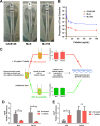Carbapenem-Resistant Klebsiella pneumoniae Exhibiting Clinically Undetected Colistin Heteroresistance Leads to Treatment Failure in a Murine Model of Infection
- PMID: 29511071
- PMCID: PMC5844991
- DOI: 10.1128/mBio.02448-17
Carbapenem-Resistant Klebsiella pneumoniae Exhibiting Clinically Undetected Colistin Heteroresistance Leads to Treatment Failure in a Murine Model of Infection
Abstract
Antibiotic resistance is a growing crisis and a grave threat to human health. It is projected that antibiotic-resistant infections will lead to 10 million annual deaths worldwide by the year 2050. Among the most significant threats are carbapenem-resistant Enterobacteriaceae (CRE), including carbapenem-resistant Klebsiella pneumoniae (CRKP), which lead to mortality rates as high as 40 to 50%. Few treatment options are available to treat CRKP, and the polymyxin antibiotic colistin is often the "last-line" therapy. However, resistance to colistin is increasing. Here, we identify multidrug-resistant, carbapenemase-positive CRKP isolates that were classified as susceptible to colistin by clinical diagnostics yet harbored a minor subpopulation of phenotypically resistant cells. Within these isolates, the resistant subpopulation became predominant after growth in the presence of colistin but returned to baseline levels after subsequent culture in antibiotic-free media. This indicates that the resistance was phenotypic, rather than due to a genetic mutation, consistent with heteroresistance. Importantly, colistin therapy was unable to rescue mice infected with the heteroresistant strains. These findings demonstrate that colistin heteroresistance may cause in vivo treatment failure during K. pneumoniae infection, threatening the use of colistin as a last-line treatment for CRKP. Furthermore, these data sound the alarm for use of caution in interpreting colistin susceptibility test results, as isolates identified as susceptible may in fact resist antibiotic therapy and lead to unexplained treatment failures.IMPORTANCE This is the first report of colistin-heteroresistant K. pneumoniae in the United States. Two distinct isolates each led to colistin treatment failure in an in vivo model of infection. The data are worrisome, especially since the colistin heteroresistance was not detected by current diagnostic tests. As these isolates were carbapenem resistant, clinicians might turn to colistin as a last-line therapy for infections caused by such strains, not knowing that they in fact harbor a resistant subpopulation of cells, potentially leading to treatment failure. Our findings warn that colistin susceptibility testing results may be unreliable due to undetected heteroresistance and highlight the need for more accurate and sensitive diagnostics.
Keywords: Klebsiella; antibiotic resistance; clonal heteroresistance; colistin; heteroresistance.
Figures


References
-
- The Review on Antimicrobial Resistance. 2016. Tackling drug-resistant infections globally: final report and recommendations. The Review on Antimicrobial Resistance, London, United Kingdom: https://amr-review.org/Publications.html.
-
- Magill SS, Edwards JR, Bamberg W, Beldavs ZG, Dumyati G, Kainer MA, Lynfield R, Maloney M, McAllister-Hollod L, Nadle J, Ray SM, Thompson DL, Wilson LE, Fridkin SK, Emerging Infections Program Healthcare-Associated Infections and Antimicrobial Use Prevalence Survey Team . 2014. Multistate point-prevalence survey of health care-associated infections. N Engl J Med 370:1198–1208. doi:10.1056/NEJMoa1306801. - DOI - PMC - PubMed
-
- U.S. Centers for Disease Control and Prevention 2013. Antibiotic resistance threats in the United States. Centers for Disease Control and Prevention, Atlanta, GA.
-
- World Health Organization 2017. WHO publishes list of bacteria for which new antibiotics are urgently needed. World Health Organization, Geneva, Switzerland.
Publication types
MeSH terms
Substances
Grants and funding
LinkOut - more resources
Full Text Sources
Other Literature Sources
Research Materials

